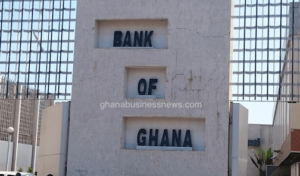Bank of Ghana’s new measures to increase competition and lending is credit positive – Moody’s
 Credit rating agency, Moody’s says the new prudential and market conduct measures announced by the Bank of Ghana (BoG) to increase competition and improve commercial banks’ operational efficiency and transparency, which the central bank expects will support the availability of credit and lower its cost is credit positive.
Credit rating agency, Moody’s says the new prudential and market conduct measures announced by the Bank of Ghana (BoG) to increase competition and improve commercial banks’ operational efficiency and transparency, which the central bank expects will support the availability of credit and lower its cost is credit positive.
According to Moody’s, the measures, included in the BoG’s monetary policy statement, were developed after the BoG’s deep review of banks’ lending practices. The measures will support Ghanaian banks’ governance framework and strengthen the lending infrastructure to support asset quality, a credit positive, it indicated.
Moody’s said in a commentary copied to ghanabusinessnews.com that, the BoG attributed limited availability and high cost of credit to banks’ operational inefficiencies and high operating costs, limited loan price transparency, high nonperforming loans (NPLs) and crowding out of the private sector by the government.
Among others, it said, to remedy the situation, the BoG will implement governance improvements such as scrutinise and link senior management and director compensation policies to banks’ overall performance including efficiency and asset quality, while enhancing the disclosure of such policies. To increase loan price transparency, banks will be required to develop and publish a clear framework on how they price loans relative to borrower risk levels.
To increase credit availability to small and mid-sized enterprises (SMEs), the BoG will facilitate those banks that participate in the Enterprise Credit Scheme by freeing up 2 per cent of banks’ cash reserve requirements they hold with the central bank, it added.
Commenting, Christos Theofilou, a vice president at Moody’s says: “Ghana’s central bank announced prudential and market conduct measures to increase competition and improve banks’ operational efficiency and transparency, which it expects will support the availability of credit and lower its cost. The measures are credit positive as they will support Ghanaian banks’ governance framework and strengthen the lending infrastructure to support asset quality.”
Moody’s notes that in October 2019 NPLs were 17.3 per cent of gross loans or 8.1 per cent excluding fully provisioned NPLs under “loss” classifications, down from 20.1 per cent and 11.4 per cent respectively in October 2018. BoG plan to improve the existing credit infrastructure by strengthening enforcement of the credit bureau and the collateral enforcement mechanism supporting bank’s underwriting and risk management practices, while a step in the right direction, in our view it will take time for banks to reduce NPLs.
It added that another key constraint to private sector credit and a primary reason for the high cost of credit is the government high domestic borrowing requirements and high government bond rates, with yields on government securities ranging from 14.7 per cent for the 91-day treasury to 20.3 per cent for the 15-year bond, posing a profitable avenue for banks to grow, in competition with the private sector lending.
The agency believes that without more coordinated actions across Ghanaian authorities and continued fiscal consolidation, competition from the government for bank funding is unlikely to be addressed in the next 12-18 months. Accordingly, the cost of credit will likely remain high, with the average lending rate at 23.7 per cent in October 2019. As part of the announcement, the BoG maintained the policy rate at 16 per cent, acknowledging continued economic growth (we expect real GDP growth of 7.2 per cent in 2019) and contained inflation within a 6 -10 per cent target.
By Emmanuel K. Dogbevi
Copyright ©2019 by Creative Imaginations Publicity
All rights reserved. This article or any portion thereof may not be reproduced or used in any manner whatsoever without the express written permission of the publisher except for the use of brief quotations in reviews.
